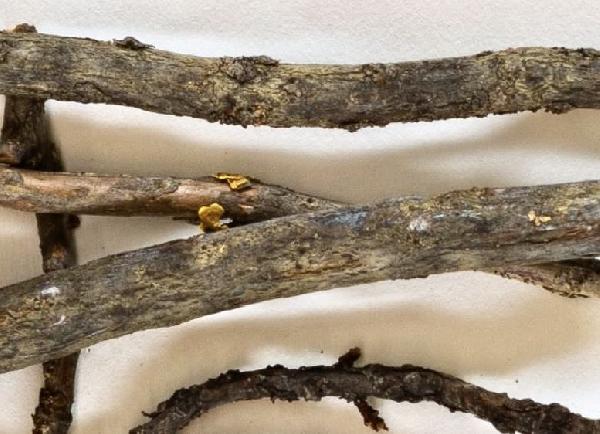Lecanora gisleri (Arnold) Arnold
Lich. Exs.: 1525, 1891. Basionym: Biatora gisleri Anzi ex Arnold - Verh. zool.-bot. Ges. Wien, 21: 1139, 1871.
Synonyms:
Distribution: N - Frl, TAA (Nascimbene & al. 2007b), Lomb (Hinteregger 1994), Piem (Isocrono & al. 2004).
Description: Thallus crustose, thinly episubstratic, smooth to warted, sometimes finely areolate, yellowish white to grey-white, rarely delimited by a dark prothallus. Medulla white, I+ blue. Apothecia indistinctly lecanorine to biatorine, rounded to angular in outline, 0.3-0.6 mm across, sparse to crowded, slightly constricted at base, with a pale brown, red-brown, finally dark brown to (rarely) brown-black, dull, at first concave, then flat to convex disc and a concolorous, smooth, finally often excluded margin. Thalline margin not always present, or developed only at the base of the apothecia, corticate, the cortex 20-30 µm thick, the medulla with a few algae mostly concentrated towards the base; proper exciple colourless to pale brown; epithecium orange-brown to brown-black, in pale apothecia with a granular epipsamma, the granules dissolving in K but not in N; hymenium colourless, 80-120 µm high, I+ dark blue; paraphyses coherent, 1.5-2 µm thick at mid-level, often branched in upper part, the apical cells 3-4 µm wide, with dark walls; hypothecium colourless, 90-120 µm high, I+ pale blue. Asci 8-spored, clavate, very thin-walled, with a K/I+ blue, tall tholus penetrated by a faintly amyloid apical cushion, the wall K/I-, surrounded by a blue outer layer, Lecanora-type. Ascospores often poorly developed, 1-celled, hyaline, narrowly ellipsoid, 11-17 x 5-7 µm. Photobiont chlorococcoid. Spot tests: thallus K- or K+ pale dirty yellow, C-, KC-, P+ orange-red. Chemistry: fumarprotocetraric acid.Note: a probably circumboreal-montane lichen found on twigs of shrubs, especially Rhododendron ferrugineum in the subalpine belt; probably restricted to the Alps in Italy.
Growth form: Crustose
Substrata: bark
Photobiont: green algae other than Trentepohlia
Reproductive strategy: mainly sexual
Commonnes-rarity: (info)
Alpine belt: rather rare
Subalpine belt: rather common
Oromediterranean belt: absent
Montane belt: absent
Submediterranean belt: absent
Padanian area: absent
Humid submediterranean belt: absent
Humid mediterranean belt: absent
Dry mediterranean belt: absent

Predictive model

Source:https://s3.msi.umn.edu/mbaenrms3fs/images/MIN_Lichens/01380/1380875_lg.jpg
Bell Museum of Natural History, University of Minnesota - Lichens (MIN:Lichens)
Catalog #: 844336
Occurrence ID: 2cdb8fe8-0966-4104-9dee-a421ffc28828
Secondary Catalog #: 1380875
Taxon: Biatora gisleri Arnold
Family: Ramalinaceae
ID Remarks: isotype of Biatora gisleri; per (Ref.) Printzen 1995
Collector: Arnold;
Date: 1869-00-00
Verbatim Date: 1869
Locality: Austria, Tyrol,
Notes: filed at MIN under 'Arnold - Lichenes Exsiccati'

Source:https://s3.msi.umn.edu/mbaenrms3fs/images/MIN_Lichens/01380/1380875_lg.jpg
Bell Museum of Natural History, University of Minnesota - Lichens (MIN:Lichens)
Catalog #: 844336
Occurrence ID: 2cdb8fe8-0966-4104-9dee-a421ffc28828
Secondary Catalog #: 1380875
Taxon: Biatora gisleri Arnold
Family: Ramalinaceae
ID Remarks: isotype of Biatora gisleri; per (Ref.) Printzen 1995
Collector: Arnold;
Date: 1869-00-00
Verbatim Date: 1869
Locality: Austria, Tyrol,
Notes: filed at MIN under 'Arnold - Lichenes Exsiccati'
Growth form: Crustose
Substrata: bark
Photobiont: green algae other than Trentepohlia
Reproductive strategy: mainly sexual
Commonnes-rarity: (info)
Alpine belt: rather rare
Subalpine belt: rather common
Oromediterranean belt: absent
Montane belt: absent
Submediterranean belt: absent
Padanian area: absent
Humid submediterranean belt: absent
Humid mediterranean belt: absent
Dry mediterranean belt: absent

Predictive model

Source:https://s3.msi.umn.edu/mbaenrms3fs/images/MIN_Lichens/01380/1380875_lg.jpg
Bell Museum of Natural History, University of Minnesota - Lichens (MIN:Lichens) Catalog #: 844336 Occurrence ID: 2cdb8fe8-0966-4104-9dee-a421ffc28828 Secondary Catalog #: 1380875 Taxon: Biatora gisleri Arnold Family: Ramalinaceae ID Remarks: isotype of Biatora gisleri; per (Ref.) Printzen 1995 Collector: Arnold; Date: 1869-00-00 Verbatim Date: 1869 Locality: Austria, Tyrol, Notes: filed at MIN under 'Arnold - Lichenes Exsiccati'

 Index Fungorum
Index Fungorum
 GBIF
GBIF

